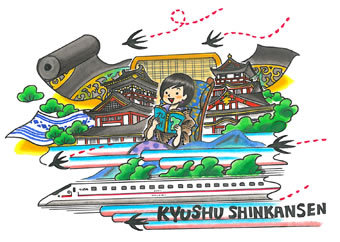Hakata Culture vol.51
Azuchi Momoyama & Kyushu Shinkansen Rich Heritage

With the opening of JR Hakata City and the commencement of full service on the Kyushu Shinkansen in March, the Hakata district has come alive. Not many people are aware of it, but some refer to the Kyushu Shinkansen as the Azuchi Momoyama on wheels. This is the name given to the period during the 16th century, when warlords Oda Nobunaga and Toyotomi Hideyoshi were powerful figures in Japan. To demonstrate their strength, they built large castles, lavishly decorated with art and sculpture. A wealthy merchant class arose during this period, creating a culture of ornate luxury. The tea ceremony also became popular, as exemplified by Toyotomi Hideyoshi’s “gold tea room,” with its gold foil-covered walls.
Believe it or not, similarly extravagant decoration can be found on parts of the new Kyushu Shinkansen. In addition to gold foil embellishment, there are also displays using the traditional Japanese craft techniques of lacquer and Hakata-ori textiles. Other exclusively Japanese touches, include rope curtains made using rush grass from Yatsushiro, Kumamoto, and wooden rolled blinds which hint at the traditional bamboo style. The Kyushu Shinkansen draws on a wealth of Japanese culture to show their hospitality to both Japanese and foreign passengers alike.
This isn’t a new policy for JR Kyushu. Before the Shinkansen began operation, the railroad was known for its design excellence. In fact, they’ve been won several Brunel Awards for international railway design. The Sonic limited express train has a stunning metallic blue exterior. The Kamome features trains with white bodies and real leather seats. The Yufuin no Mori, another limited express, has a rounded shape and a deep green color that brings forests to mind. The colorful body of the Huis ten Bosch adds to the excitement of a holiday jaunt. All these designs show a rich sense of creativity and individuality.
Now that the Kyushu Shinkansen is in full service, there’s no better time to get on board at Hakata and go exploring!
走る安土桃山?和文化満載の九州新幹線
3月に念願の全線開通となった九州新幹線。新しくなった博多駅はたくさんの人でにぎわい、博多の街は活気にあふれています。この九州新幹線、別名「走る安土桃山」と呼ばれているのをご存知でしょうか?「安土桃山」とは、戦国武将の織田信長や豊臣秀吉が活躍した16世紀ごろの時代です。各地の戦国武将は自分たちの力を示すために大きな城をつくり、内部には絵画や彫刻など華麗な装飾をほどこしました。また、この時代には庶民からも裕福な商人が次々に現れ、豪華絢爛な文化が好まれました。茶の湯も流行し、豊臣秀吉は金箔を張りめぐらせた「黄金の茶室」でお客をもてなしたといいます。
九州新幹線の一部には金箔張りの壁が使われています。また漆や博多織といった日本伝統の工芸技術を活かしたディスプレイがあちこちに飾られています。熊本・八代産のい草を使った縄のれんや、日本のすだれにヒントを得た木製のロールブラインドなど、日本ならではのデザインが満載です。日本人だけでなく、海外からのお客様をもてなすために、九州新幹線では和の文化をふんだんに取り入れているのだとか。
九州新幹線だけでなく、JR九州の列車には以前から優れたデザインの車両がたくさんあります。世界中の優れた鉄道関係のデザインを表彰する国際的な賞「ブルネル賞」を何度も受賞したことがあるのです。メタリックブルーの外観がひときわ印象的な特急「ソニック」。白い車体と本皮製のシートが豪華な特急「かもめ」。車体の深い森を思わせる緑と丸いフォルムがユニークな特急「ゆふいんの森」。カラフルなボディが遊びの気分をさらに盛り上げてくれる特急「ハウステンボス」。どれもがとても個性的です。九州新幹線が開通した今年は、博多から楽しい列車に乗って旅に出かけてはいかがでしょうか。

